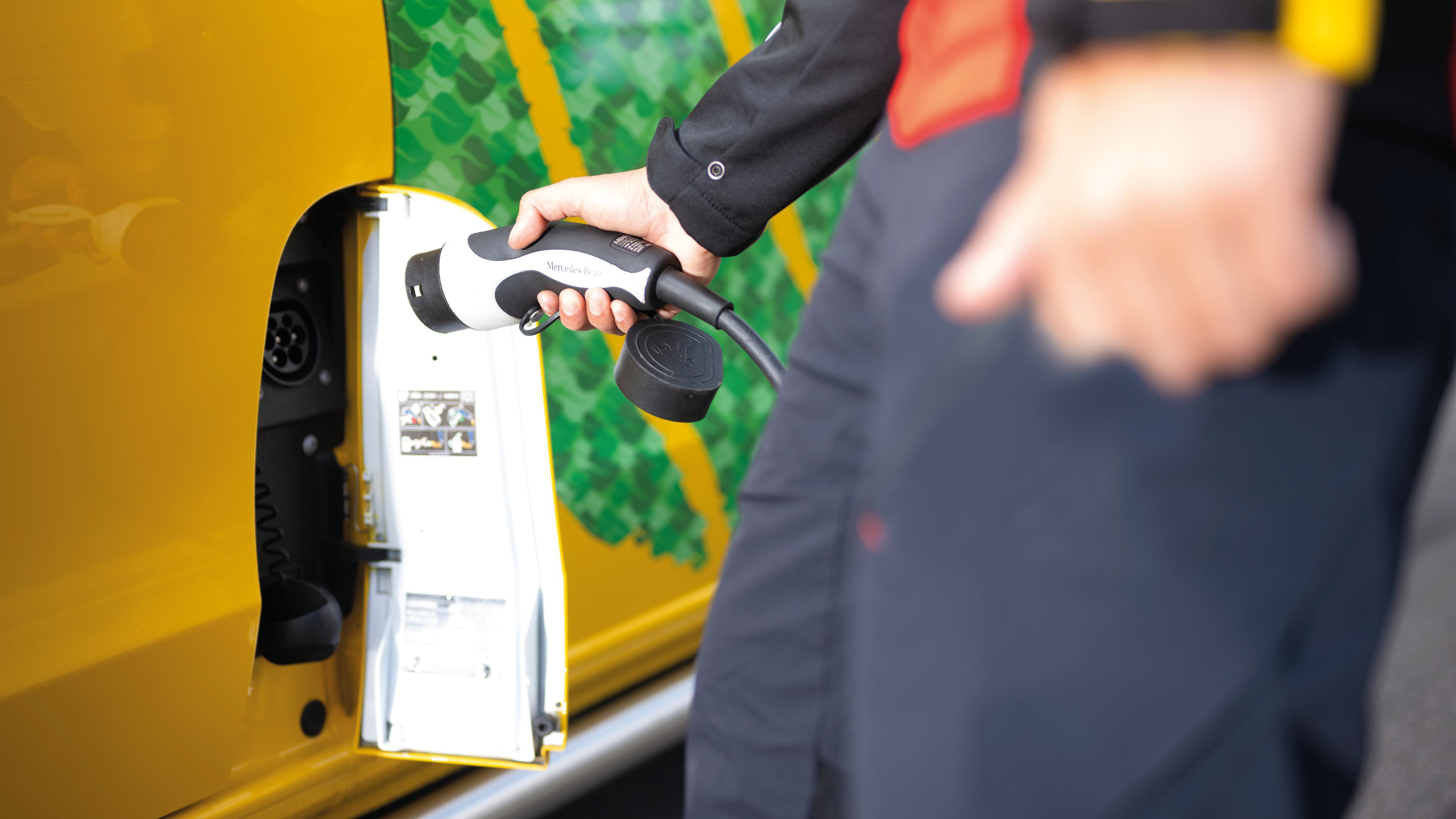
Alternative drive systems are still rare in long-haul trucking, with more than 95 percent of new truck registrations in Europe still running on diesel. At the same time, electric technology is making progress in the truck sector. However, the prerequisite for a widespread breakthrough is a European fast-charging network that meets future demand. While this is still a long way off, here you can find out which charging options are available today and what charging times can be expected.
E-Mobility in Road Freight Transport: Status Quo and Perspectives
Battery-powered delivery vehicles are a familiar sight to city dwellers. So it is almost surprising that the EU-wide market share of electric drives in vans up to 3.5 tons is only 5.7 percent of new registrations, according to the European Automobile Manufacturers Association ACEA.
And for trucks, the figure is only 2 percent. In addition to higher purchase costs, the (limited) range, (lack of) charging infrastructure, and (lengthy) charging times remain barriers to e-mobility in road freight transport. For short distances, a single battery charge is sufficient and vehicles can easily be charged overnight at a company’s premises. Charging time is of little concern, and public charging infrastructure is usually not required.
Furthermore, the additional weight of the batteries is a limiting factor in long-haul trucking. This increases the weight of the vehicle, which decreases the payload, since electric trucks must comply with the maximum permissible gross vehicle weight. The limited payload due to the weight of the battery can be partially compensated by a legal increase in the permissible gross weight. In many countries, electric trucks are already allowed to drive with a higher permissible gross weight than trucks with combustion engines – and the maximum payload is often not reached even when the load volume is fully utilized, so that electric trucks are already an option in heavy goods transport today.
Manufacturers Promise Greater Range
Long-distance road freight with larger vehicles is a different story than urban delivery. Currently, typical market ranges of electric trucks are between 300 and 500 kilometers. But manufacturers are catching up and promise longer ranges of up to 1000 kilometers. Stricter European climate targets are forcing manufacturers to develop new products in the electric segment: in early 2024, the European Parliament and member states agreed on emissions regulations for commercial vehicles over 7.5 tons to be delivered as of 2030. Their CO₂ emissions are to be reduced by 45 percent between 2030 and 2034 compared to 2019. The requirements will be further tightened in 2035 (65 percent) and 2040 (90 percent).

Options for Electric Truck Charging
Although in principle many electric trucks could use the same public charging stations as cars, in practice this is often impossible due to the larger dimensions of the vehicles. Other obstacles are safety aspects related to the charging process or the guarantee of a charging option via a reservation system. For these reasons, the typical charging point for electric trucks today is not so much the public charging station, but:
- own premises
- third-party facilities (e.g., loading and unloading points at the shipper/recipient or at distribution centers); sometimes corporate partnerships allow the use of third-party charging stations
Overnight charging is still the most common charging method. Overnight charging is possible at low power levels of 50-100 kW direct current (DC) or at less than 45 kW alternating current (AC), as several hours are available to fully charge the vehicles. Especially for battery capacities below 250 kWh, AC systems are in most cases absolutely sufficient for overnight charging.
Charging at the destination is essential if the truck’s range is insufficient for the round trip. Charging stations on company premises or in distribution centers often have a DC power output of 150 to 400 kW, so that electric trucks can be theoretically charged directly in up to 2 hours during loading and unloading.
Charging en route in long-haul trucking must be faster than this. Regular driving breaks are mandatory in the EU (45-minute break after 4.5 hours of driving). To recharge trucks with their large batteries at public charging stations and motorway services during these breaks, higher power levels are required – and a different charging system than for cars.
Prices for Charging
Of course, the actual price will vary depending on the provider. In general, slow charging with AC is cheaper than faster charging with DC. Typical market prices at public charging stations in the fall of 2024 are €0.50-0.60 per kilowatt hour (AC) or €0.60-0.75 (DC). When charging on company premises, the price will of course depend on the electricity tariff at which the company buys its electricity, as well as the investment costs for the charging infrastructure and the ongoing costs for back-end operation and maintenance. Possible public subsidies are a potential financial reduction factor.
CCS and MCS
The European standard for charging electric cars is the Combined Charging System (CCS). This also works for light and medium-duty trucks. Charging is done with a type 2 or CCS connector in the same way as for cars. This takes a relatively long time and is only practical for overnight charging. A more efficient standard with a higher charging capacity than CCS is thus a prerequisite for the widespread use of e-mobility in road freight.
This charging standard is the Megawatt Charging System (MCS), which is the future standard for charging heavy-duty vehicles. Most new electric trucks are MCS-compatible and generally come with two connectors (MCS and CCS). MCS enables significantly higher charging capacities, making heavy-duty trucks suitable for long trips. MCS is currently the most practical solution for public charging en route during legal rest periods. There are possible applications on company premises, although the required medium-voltage connection may limit their use at some locations.

No Long-Range E-Mobility Without Fast Charging Infrastructure
In Europe, the public charging infrastructure for trucks is best developed in Germany, the Netherlands, and France. But even in Germany, there are only about 70 public fast-charging stations. The German National Centre for Charging Infrastructure is pursuing a strategy of creating around 350 locations with fast-charging facilities for trucks at service stations on federal highways. In Europe’s main transit country, this is especially important. An EU regulation stipulates that the maximum distance between charging stations on the trunk road network must not exceed 60 kilometers.
The development of a demand-driven charging infrastructure in Europe is unlikely to result in an extensive network of numerous charging stations in each country. Instead, there will be a smaller quantity of powerful multi-megawatt charging stations in strategic locations to provide a large number of fast charging connections per station.
Charging Times of Electric Trucks with Different Systems
When it comes to charging electric trucks, the first thing to consider is that the required battery capacity is significantly higher than for cars. Capacities between 60 and 100 kWh are typical for cars, while values of around 250 kWh are typical for smaller vans and over 600 kWh for heavy-duty and long-haul trucks. The charging time is correspondingly longer.
With an AC charger (< 45 kW), light-duty vehicles with batteries up to 250 kWh can be charged in 8 to 10 hours. With a charging capacity of 150 kW (DC), however, it is also possible to charge 400 to 500 kWh batteries relatively quickly via a CCS plug.
MCS enables charging capacities in excess of one megawatt. But it should be noted that in the industry, high charging capacities of less than 1 MW are also referred to as MCS charging. Nevertheless, charging times of less than 30 minutes are only possible with a charging capacity of more than one megawatt. Due to the infrastructure investment and medium-voltage connections required, such MCS systems are likely to be found only on Europe’s major highways – and that is where fast-charging systems make the most sense.
The charging times given in the table are rough estimates for charging the battery from 10 to 80 percent. Actual charging times will vary depending on the battery/batteries installed:
- Battery capacity
- Battery C-rate, a measure of the charge or discharge rate in relation to the battery capacity. The higher the C-rate, the shorter the charging time, but the greater the wear and tear on the battery.
As a result, the actual charging time depends strongly on the e-truck model. Vehicles with very high payloads and correspondingly high engine power and battery capacity are not likely to achieve the charging target of less than 30 minutes.
Tabular Overview of Typical Electric Truck Charging Times
| Charging capacity | Charging time | Charging system | Vehicle application |
|---|---|---|---|
| < 45 kW | 10 h (Small trucks with a battery capacity of up to 250 kWh can be fully charged in 10 h.) | CCS (AC) | Local transport |
| 50 to 100 kW | 6 to 10 h (Large batteries [600 kWh] require a charging time of up to 12 h.) | CCS (DC) | Regular service |
| 150 kW | 2 to 4 h | CCS (DC) | Local transport / regular service |
| 250 to 400 kW | 40 min to approx. 2.5 h (Example: for a 600 kWh battery, this results in a charge time of approx. 1.5 h [400 kW charge capacity] to approx 2.5 h [250 kW].) | CCS (DC) | Regular service |
| 500 to 750 kW | approx. 50 to approx. 110 min (Example: for a 600 kWh battery, this results in a charge time of approx. 50 min [750 kW charge capacity] to approx. 110 min [500 kW].) | MCS (DC) | Regular service / long-haul transport |
| ≥ 1 MW | < 30 min (In terms of figures, this results in an average charge time of 36 min for a 600 kW battery and 1 MW charging power.) | MCS (DC, not yet available) | Regular service / long-haul transport |
eTruckathon
In September 2024, E.ON Drive’s eTruckathon in Germany showed just how far electric truck technology has come. Pioneers from the automotive and logistics industries joined forces for a sustainable demonstration drive from Essen to IAA Transportation in Hanover. DHL Freight, a forerunner in sustainable logistics, was at the start with its own electric truck, and twelve vehicles from twelve teams proved on their 300-kilometer trip with zero emissions that sustainable logistics is no longer a mere vision.
Conclusion: Infrastructure Expansion and Technology Development Reduce Charging Time for Electric Trucks
Purchase price, range, fast-charging network: if adjustments are made in the right direction, e-mobility can successfully enter the European road freight market on a broad scale. This would be a major ecological benefit for transport logistics as a whole.
DHL Freight is part of this sustainable movement. E-mobility is an important element of DHL Freight’s and DHL Group’s sustainability strategy, which aims to achieve net-zero logistics-related emissions by 2050. Our cooperation with Parker Hannifin in the area of electric road freight, the all-electric heavy goods transport at the Hagen and Koblenz sites, and the use of electric trucks in the Netherlands show what is already working today in terms of electric trucks. The deployment of e-mobility is particularly advanced at DHL Freight in Sweden, where many routes are already fully electric. In Sweden, DHL Freight has already carried out a pilot project with Volvo for long-haul heavy goods transport in 2021. But DHL Freight is open to all kinds of new technologies. We want to achieve the transition to the green logistics of tomorrow as quickly as possible with a mix of different alternative truck drives.



